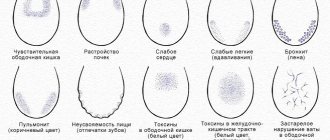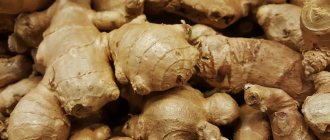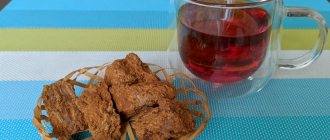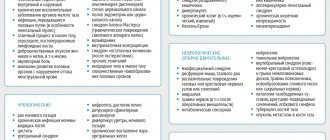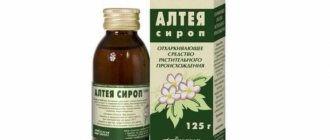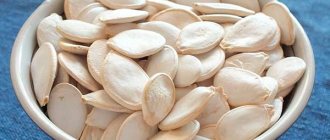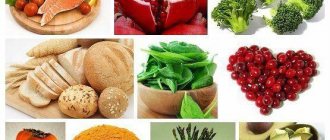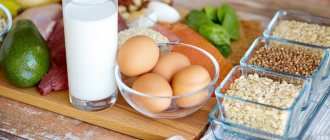© LMproduction – stock.adobe.com
Share:
Pumpkin is a healthy and tasty vegetable that is eaten in a wide variety of forms. Thanks to its chemical composition, pumpkin is extremely popular among those who are on a diet or simply stick to proper nutrition, and for athletes this vegetable is a godsend. Pumpkin pulp is quickly digestible, which allows you to eat it at almost any time of the day. However, this melon crop also has contraindications for use.
In the article we will look at who can eat pumpkin and who is strictly not recommended, and find out what useful substances this melon crop is rich in.
Nutritional value and composition of pumpkin
The composition of pumpkin pulp and its nutritional value depend on the specific plant variety. But no matter what variety you choose, it will always be healthy and nutritious.
Pumpkin is 90% water. This is a big plus for those who watch their figure. But nevertheless, it contains a huge amount of nutrients and microelements. Let's find out the composition of this storehouse of vitamins. Below is a table that shows all the nutritional properties and chemical composition of the vegetable crop (the table shows values per 100 g of classic food pumpkin):
| Nutrients | Quantity in product (per 100 g) |
| Squirrels | 1 g |
| Fats | 0.1 g |
| Carbohydrates | 4.4 g |
| Alimentary fiber | 2 g |
| Water | 90.8 g |
| Starch | 0.2 g |
| Ash | 0.6 g |
| Mono- and disaccharides | 4.2 g |
| Organic acids | 0.1 g |
| Vitamin A | 250 mcg |
| Vitamins PP | 0.5 mg |
| Beta carotene | 1.5 mg |
| Vitamin B1 | 0.05 mg |
| Vitamin B2 | 0.06 mg |
| Vitamin B5 | 0.4 mg |
| Vitamin B6 | 1.6 mg |
| Vitamin B9 | 14 mcg |
| Vitamin C | 8 mg |
| Vitamin E | 0.4 mg |
| Calcium | 25 mg |
| Magnesium | 14 mg |
| Sodium | 4 mg |
| Potassium | 204 mg |
| Phosphorus | 25 mg |
| Chlorine | 19 mg |
| Sulfur | 18 mg |
| Iron | 0.4 mg |
| Zinc | 0.24 mg |
| Iodine | 1 mcg |
| Copper | 180 mcg |
| Manganese | 0.04 mg |
| Cobalt | 1 mcg |
| Fluorine | 86 mcg |
As you can see from the table, there are a lot of useful things in the vegetable. As for the calorie content of pumpkin, it all depends on how it was prepared. For example, boiled pumpkin has 20 kcal, baked pumpkin has a little more - 22 kcal. Calorie content directly depends on what is added to the pumpkin. If you want to pour honey on the vegetable or sprinkle it with sugar, its energy value can increase to 50 kcal per 100 g.
Pumpkin is a universal product, and this allows you to eat it in the morning, afternoon and evening.
You need to choose a good and tasty pumpkin. When buying a vegetable, give preference to dense and fleshy varieties of bright orange color: these are the fruits that will be tasty and sweet. Pale varieties are forage varieties. Such vegetables have an inexpressive taste. Do not buy pumpkins that have dents or cracks: the shell of the vegetable has already been damaged, which means the process of rotting may begin inside.
© bozhdb – stock.adobe.com
What are the benefits of pumpkin oil?
Pumpkin oil is obtained from the seeds of the plant using the cold pressing method. Pumpkin oil contains essential and fatty oils, pectins, vitamins, selenium and sterols. Pumpkin oil can reduce swelling, improve metabolic processes occurring in tissues, and also helps with burns, as it relieves inflammation. Pumpkin oil is used for proctological diseases, as it relieves pain, itching and burning.
Pumpkin oil contains a lot of vitamin A, so it is recommended for use for eye diseases. Pumpkin oil can treat prostate adenoma and prostatitis. Pumpkin oil has wound healing and restorative properties. In addition, pumpkin oil is used for diseases that are accompanied by disorders of lipid metabolism in the body, such as, for example, obesity, eczema or dermatitis.
Benefits of pumpkin for humans
Pumpkin is especially useful for the female body. A large amount of vitamin E has a beneficial effect on skin, nails and hair. Gynecologists recommend eating autumn vegetables to increase the chances of pregnancy, since vitamin E is involved in the formation of new healthy cells. But for those who have already experienced menopause, pumpkin will be a good antidepressant that will help get rid of unpleasant feelings during this period.
Pumpkin retains its beneficial properties after baking, boiling or steaming.
Not only the pulp of the pumpkin is edible, but also the seeds. They are high in magnesium, zinc and protein. But the energy value of the seeds is much greater than that of the pulp. 100 g of seeds contain 556 kcal, so they should be introduced into your diet carefully. For example, they make oil that can be added to salads; in this form, this product will be more beneficial.
Many men are also interested in the benefits of pumpkin. The stronger sex should pay attention to the seeds, since they contain a lot of zinc, and it is he who is involved in the production of testosterone. Regular consumption of pumpkin seeds protects men from prostatitis. Men should also drink pumpkin juice, as it is very restorative. This is a great option to refresh yourself after a hard workout.
The benefits of pumpkin for the human body are as follows:
- It has a diuretic effect (you remember that it is 90% water), which helps people who suffer from kidney problems. Raw pumpkin is recommended for use by people with kidney failure, as well as for the prevention of tuberculosis.
- Since pumpkin is a strong antioxidant, it is useful in preventing any pathogenic processes at the cellular level.
- For those who are obese or struggling with excess weight, pumpkin is a real godsend, as it helps digest foods faster.
- With constant consumption of pumpkin pulp, blood pressure normalizes. For people who play sports (active fat-burning workouts, which lead to increased blood pressure, are especially popular now), a few pieces of pulp will help normalize blood pressure levels.
- Although pumpkin does not have much vitamin A, it also has a beneficial effect on vision.
- Pumpkin is high in vitamin C, which supports the immune system. With the onset of autumn, try to eat vegetables as often as possible - you will get sick less.
Scientists have noticed that regular consumption of this autumn beauty normalizes sleep, so those who suffer from insomnia should definitely introduce pumpkin into their diet.
This melon crop has a good effect on the gastrointestinal tract (gastrointestinal tract). Therefore, people who suffer from constipation are recommended to make themselves a paste from fresh pumpkin. This treat is eaten for breakfast and better on an empty stomach. You shouldn’t worry about stomach discomfort; there won’t be any, since pumpkin is easily and quickly digested (it doesn’t matter whether it has been heat-treated or not). Also, raw pumpkin will benefit those who have liver problems - only in this case it is better to eat it for lunch or dinner.
Human health is a complex mechanism that needs to be carefully monitored, and pumpkin is an excellent assistant in this matter. If this vegetable is constantly in your diet, your well-being will improve, and your systems and organs will function without failure.
Since pumpkin is a gift of autumn, it does not grow all year round. But it can be prepared, for example, by freezing it in pieces or placing it whole in a cold and dark cellar. Pumpkin has excellent shelf life and the ability to be transported over long distances.
Healthy fiber
Pumpkin pulp is rich in coarse plant fibers, consisting of fiber that our digestive tract does not absorb. But the benefit of coarse fibers, as is known, lies not in nutritional value, but in the fact that they activate intestinal motility and remove food toxins. In addition, consuming fiber helps reduce the risk of heart and vascular diseases, as well as improve immunity, which is not a bad thing for many people in the fall.
The fiber contained in pumpkin has another very useful property: it swells when it enters the stomach, giving a person a feeling of fullness. Therefore, pumpkin dishes are recommended for people who want to lose weight: there are few calories in the pulp, but you won’t feel hungry.
Beneficial properties during strength training
People involved in strength training will benefit most from pumpkin seeds. For athletes, they will be healthier than pulp, since the seeds contain the maximum vitamin E content, and it reduces the likelihood of injury to muscle tissue during exercise (this is especially true for people who lift a lot of weight in the gym).
For those who engage in heavy sports, pumpkin seeds will help “build” and not lose muscle mass. This is possible thanks to vitamins E and C. During intense exercise, muscles can tear (many people call this “soreness”, but in fact muscle pain means that the fibers are torn), this is normal if the athlete has intense or strength training. But it is important that the fibers recover quickly and well. This is where vitamins C and E come to the rescue, promoting rapid recovery. Vitamin E is responsible for elasticity and helps muscles stretch well and “heal” properly after exercise. Eating pumpkin pulp and seeds keeps the body in good shape and prevents the muscles from “rusting” and stagnating. Men are recommended to eat a glass of seeds a day for a month, then take a break for the same period.
© amy_lv – stock.adobe.com
Only raw seeds are considered beneficial. If they are fried, there will be no benefit from them, only extra calories. Proper consumption of seeds will be beneficial, despite the high calorie content, since a lot of strength and energy is spent during exercise.
Women who are involved in bodybuilding, on the contrary, should give preference to pumpkin pulp, since it does not have such a high calorie content (the female body, unfortunately, absorbs the excess faster).
In addition to having a positive effect on human muscles, pumpkin is often used in weight loss, especially by women. This issue is worth understanding in more detail.
The dangers of overeating pumpkin
It is not recommended to eat more than 200-300 grams of pumpkin dishes per day, since the intestines, oversaturated with coarse fiber, may not be able to cope with the load and stop. Abdominal distension, nausea, constipation - these are the likely consequences of overeating pumpkin.
You should also be careful with pumpkin seeds, which are often added to porridges, baked goods, cottage cheese dishes, etc. They promote the production of the pleasure hormone dopamine, and in their raw form they also expel parasites from the intestines. But do not forget that pumpkin seeds are very high in calories, and infatuation with this delicacy can lead to weight gain.
Back to list Previous article Next article
Benefits for weight loss
For weight loss and cleansing the body, pumpkin is an indispensable product. Girls in pursuit of a slim figure choose a variety of methods, and pumpkin diets are no exception. However, the best diet is proper nutrition. Only a properly structured diet and physical activity will help achieve good results.
If you decide to use pumpkin in your diet at the weight loss stage, give preference to dishes made from fresh vegetables. For example, fresh salads and cold cream soups are great options. Pumpkin cocktails and smoothies will be a good source of vitamins after a workout, so take pre-prepared fresh juice with you. In addition to pumpkin, choose your favorite fruits and vegetables.
We have already mentioned earlier that pumpkin has a beneficial effect on the intestines, therefore, at the stage of weight loss, the vegetable is used as a cleansing component, taken on an empty stomach.
The main thing is to remember that with the pumpkin diet you can only drink green tea, pumpkin juice and still water.
© M.studio – stock.adobe.com
If you cannot give up coffee, drink the drink no more than once a day. It is recommended to drink coffee, like tea, without sugar.
But how do you take pumpkin for weight loss? There are a few rules to remember:
- Every day you need to drink a glass (200 ml) of pumpkin juice on an empty stomach, preferably 20 minutes before meals;
- drink a glass of water or green tea before meals throughout the day;
- exclude sweet fruits from the diet during the diet;
- if you feel hungry, eat pumpkin - a few pieces will be enough;
- You can't eat after six in the evening.
For main dishes, choose cereals, such as buckwheat. You should also eat several pieces of vegetables at each meal. As an alternative to the usual dishes, pumpkin soups, stews, etc. are suitable.
The pumpkin diet gives good results, the main thing is to stick to the regime.
What are the benefits of pumpkin juice?
Pumpkin juice has the same beneficial properties as the pulp. Freshly squeezed juice has a thick consistency and a subtle honey flavor. It retains a high concentration of minerals, vitamins, antioxidants, and pectins.
Pumpkin juice is recommended as a preventive and therapeutic agent for a number of diseases:
- Cold.
- Flu.
- Hemorrhoids.
- Nervous disorders.
- Digestive disorders (constipation).
- Nausea and vomiting.
- Urolithiasis.
- Metabolic disorder.
In the midst of seasonal viral infections, it is recommended to drink 200 ml of freshly squeezed pumpkin juice daily.
Juice from pumpkin pulp is used in cosmetology. It is used as lotions and lotions for:
- Skin restoration after dermatological diseases.
- Achieving a rejuvenating effect.
- Eliminate redness.
- Acne treatment.
- Improving the condition of hair and nails.
- Regeneration of cells in the deep layers of the skin.
Pumpkin juice contains an almost ideal proportion of vitamin C and B vitamins. This makes it very useful for people with central nervous system problems. The juice helps fight depression, gives vitality, relieves fatigue and calms.
Hematologists recommend pumpkin juice to patients with bleeding disorders. The drink contains vitamin K, which helps normalize the blood formula. Pumpkin juice is an essential component of the diet for older people, who often suffer from vitamin K deficiency.
How to drink pumpkin juice correctly?
Pumpkin juice can be drunk in its pure form, or combined with other vegetables (carrots). To improve the absorption of beta-carotene, cream is added to the drink. Animal fats ensure complete absorption of all valuable components.
The daily volume of juice should be 200 ml. This amount is divided into two servings and drunk at breakfast and before bed. For better absorption, take it with meals. A pronounced positive result is noticeable after 7-10 days.
How to make pumpkin juice?
Housewives prepare pumpkin juice in different ways - from fresh, boiled pumpkin, or canned for the winter.
The easiest method is using an auger juicer. For this:
- Wash the pumpkin and cut it lengthwise into two parts.
- Remove seeds and fibers.
- Cut into small pieces.
- Remove the skin from the prepared lobes.
- Cut the peeled vegetable into smaller pieces.
- Pass through a juicer.
If you don’t have a juicer at hand, it doesn’t matter, you can use another method:
- Cut clean pumpkin, remove seeds and fibers.
- Remove the skin and cut into pieces.
- Place the prepared pieces into a saucepan and add water.
- Cook over low heat.
- After 40 minutes, remove the pan from the heat, grind the pulp with a blender, and grind with a masher.
- Add sugar and lemon juice to the resulting puree to taste.
- Pass the puree through a sieve, rubbing with a spoon.
- The resulting mass is placed on the fire, brought to a boil and boiled for 5 minutes.
Heat-treated pumpkin juice loses some of its active properties, but still retains its beneficial qualities. For therapeutic or preventive purposes, it is better to use fresh juice obtained from raw pumpkin pulp.
Harm and contraindications
For whom the product is contraindicated and should either limit its consumption or completely exclude it from your diet:
- Diabetics. Pumpkin contains a lot of starch; when heated, it breaks down and is better absorbed by the body, so the glycemic index may be higher than that of the raw product. As a result, baked, boiled and steamed pumpkin will increase blood sugar levels. If you have type 2 diabetes, you can only eat raw pumpkin and then in limited quantities.
- People with acute gastrointestinal diseases should also avoid eating pumpkin.
- Those who suffer from gastritis should be careful with seeds: they can only worsen the condition, as they contain salicylic acid, which irritates the mucous membrane.
- During pregnancy, you should avoid eating pumpkin seeds, as they can trigger early labor.
Be careful with pumpkin juice: it can cause nausea and bloating, and in some cases lead to diarrhea. It is better not to drink juice in the evening.
Important! Pumpkin has a choleretic effect, so people with gallbladder problems should be more careful with the vegetable.
Benefit and harm always go hand in hand, walking on a fine line. But one thing is certain: if you eat pumpkin in moderation, then nothing bad will happen.
2K 0 Recipe for stewed green beans with tomatoes
- #vegetarian dish
- #second course
- #for vegans
- #breakfast
- #low calorie
- #dinner
- #roasting
- #vegetables
- #tomato
- #green beans
- #only fruits and vegetables
- #dinner
show more
How to choose the “right” pumpkin?
You can buy pumpkin at any time of the year in supermarkets, farm shops, and markets. When choosing a vegetable, pay attention to the main factors:
- Uniform coloring.
- No mechanical damage, dents, or dark areas.
- Firmness – the pumpkin should not be soft.
- Shape - oblong fruits are sweeter, but it is better to eat round seeds.
- Fragrant aroma.
- A slightly dried tail with no signs of rotting.
The ideal storage temperature for pumpkin is no more than +7°C. In a dry, cool place it can be stored throughout the winter.
Simple pumpkin recipes
You can make soups, porridges, pancakes and much more from pumpkin. I will give you some interesting, tasty recipes from this healthy vegetable. Surely many people like Korean carrots. I’ll tell you how to cook pumpkin in this style. I will also share simple secrets for making pancakes and aromatic porridge with the addition of pumpkin.
For Korean pumpkin you need to take 0.5 kg. fruit pulp and grate into thin, long strips. Finely chop a medium-sized onion and fry in vegetable oil, then add to the pumpkin mixture. Two cloves of garlic and a spoon of honey will enhance the taste of the dish. For seasoning, use two teaspoons of apple cider vinegar, hot red pepper and salt. At the end of cooking, you need to put the finished dish under pressure in the refrigerator for three hours.
You can pamper your children and husband with pumpkin pancakes To prepare them, take 300 grams of pumpkin pulp and grate it on a coarse grater. Then break two eggs into a cup with grated pulp, add three tablespoons of sugar, half a teaspoon of salt and 200 grams of flour. Mix the resulting mixture thoroughly until it has a homogeneous consistency, then form pancakes and fry in vegetable oil on both sides for several minutes.
Milk millet porridge is a very healthy dish, and pumpkin will help make it richer and more flavorful. To prepare, cut the pumpkin into small square pieces, add milk and cook for 15 minutes.
A glass of millet should first be scalded with boiling water, then the water should be drained and the grain should be poured into a pan with milk and pumpkin pulp. After this, it is recommended to cook the porridge for 10-15 minutes; if desired, you can add salt or sugar, and it would be nice to put a piece of butter in the finished porridge.
Description
Pumpkin is a representative of plants belonging to the pumpkin family. Pumpkin can be annual or perennial. The leaves of the pumpkin are large, hairy or hard-rough, its branches are creeping or clinging. During flowering, the plant is covered with large white or yellow flowers. The pumpkin fruit is large, often reaching a large size: from 2 to 9 kg.
Pumpkin is a tasty and healthy vegetable. First and second courses, jam, and juice are prepared from it. All parts of the plant are used in folk medicine. The seeds are a well-known remedy against worms; the pulp has a choleretic and diuretic effect. Pumpkin maintains health and replenishes the lack of vitamins and minerals.
Pumpkin for liver cleansing
The liver consists of cells - hepatocytes, which are destroyed by poor diet, alcohol and drug abuse. An important property of pumpkin for the liver is the restoration of destroyed hepatocytes and assistance in cell division.
The pulp cleanses the liver of waste. One fasting day on pumpkin is enough for the liver to return to normal.
500 gr. Grind raw berries, divide into 5-6 servings and consume throughout the day.
Pumpkin for the gallbladder
Pumpkin has a mild choleretic effect and improves the fluidity of bile. After a hearty feast or for prevention, take advantage of the healing properties of the fruit and prepare medicines based on it.
- Take 500 g of raw pulp and pass through a meat grinder.
- Add olive or sunflower oil to the resulting porridge - 100 g. and 2 tablespoons of warty birch buds.
- Leave for a week and take 3 times a day, 2 tablespoons before meals.
Pumpkin oil
Pumpkin oil is made by cold pressing the seeds. Due to the high concentration of active ingredients, the product is considered homeopathic and is sold in pharmacies. It contains several essential acids and valuable substances.
- Phytosterols. Reduce the risk of developing cancer.
- Flavonoids. A group of antioxidants that strengthen the immune system and have an antimicrobial effect.
- Phospholipids. They have a positive effect on the skin condition with eczema and psoriasis.
- Tocopherols. Protect tissues at the cellular level.
- Carotenoids. Slow down aging, help strengthen bone tissue, teeth, stimulate the production of visual pigment in the retina.
Pumpkin for the winter
Dried pumpkin
Dried pumpkin recipe
- Remove the skin and seeds from a well-ripened table pumpkin
- Cut into small slices (about half a centimeter thick).
- To improve color, you can blanch for 1-2 minutes in boiling, lightly salted water, then quickly cool in cold water and dry in a sieve.
- Then place it on a baking sheet and put it in the oven , where the pumpkin will dry at a temperature of +55...+60°C for 5-7 hours!
- dry for another 2 hours at a temperature of +70...+80 °C.
Dried pumpkin recipe
- Cut pumpkin of any dessert variety cubes 3 by 3 cm.
- We leave it in the air for a while , then in the sun - the pieces will become limp.
- Preheat the oven to +60 degrees.
- Place the pieces on a tray and dry (with the door open!).
- Let's try.
- When ready, sprinkle with powdered sugar.
- Store in paper bags.
Pickled pumpkin
Ingredients:
- water - 1l;
- vinegar 9% - 80 ml;
- salt - 30 g;
- sugar - 20 g;
- bay leaf, black pepper, cinnamon and cloves;
- and, of course, pumpkin.
Preparation:
- Peel the pumpkin and cut into cubes, then scald and cool.
- Place pumpkin, spices in prepared jars and fill with marinade.
Pumpkin in medicine
The medicinal properties of pumpkin, due to the high content of vitamins, amino acids and mineral compounds, are actively used in folk medicine.
For gastritis
Pumpkin is approved for use only in hyperacid forms of gastritis. If a person has low acidity of gastric juice, the fruit causes intestinal obstruction and is not digested in the stomach. In other cases, the product is included in diet therapy. It relieves irritation of mucous membranes, accelerates regeneration, and relieves symptoms of exacerbation.
For pancreatitis
Raw pumpkin should not be consumed during an exacerbation of the disease. During the acute period, it is allowed to take the pulp in cooked form.
Introduce it into the diet gradually:
- for the first time, eat up to 100 g of vegetable puree;
- if well tolerated, increase the serving size by 50 g daily;
- maximum amount per day - 300 g.
During the period of remission, you can add cream, spices, sugar and vegetable oil to the puree.
For diabetes
For diabetes, raw pulp is allowed to be consumed. Its glycemic index is 25 units. When baking and cooking, the GI increases to 70-85 units, so the prepared product is not recommended for use in insulin-dependent and non-insulin-dependent forms of pathology. The daily norm is 200 g.
For colitis
You can bake the pumpkin or fry it in a dry frying pan. Small amounts of dried and raw seeds are allowed.
For the liver
Beta-carotene and carotenoids contained in the pulp and peel of pumpkin are beneficial for hepatocytes. They remove toxins from the blood, reduce the load on the liver, and have a detoxifying effect.
For hemorrhoids
To relieve the symptoms of hemorrhoids, it is recommended to drink pumpkin juice. To treat the disease, you should use the liquid of the ripe fruit, which must be filtered. Take 50-70 ml on an empty stomach in the morning and evening. Therapy lasts 4 weeks.
For cholecystitis
If the gallbladder is inflamed, you need to eat the seeds. The daily norm is 70-100 g. During the period of remission, it is allowed to include boiled, baked and steamed pulp in the diet.
For constipation
This fruit has a mild laxative effect, facilitates the excretion of feces, and enhances intestinal motility. For constipation, you can eat boiled pumpkin.
For gout
Pumpkin reduces serum uric acid levels, prevents the thinning of cartilage tissue and the deposition of mineral salts in the joint capsule. For gout, it is allowed in any form.
